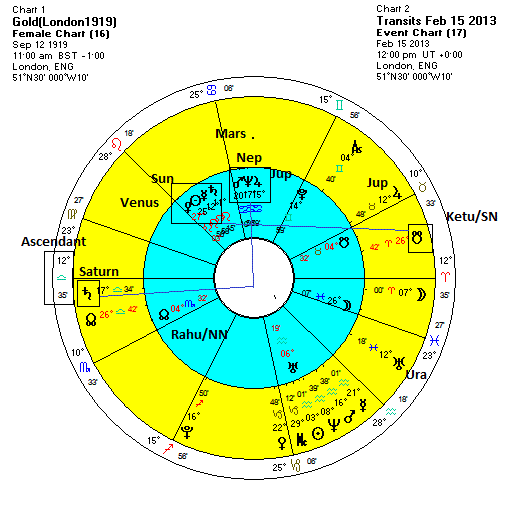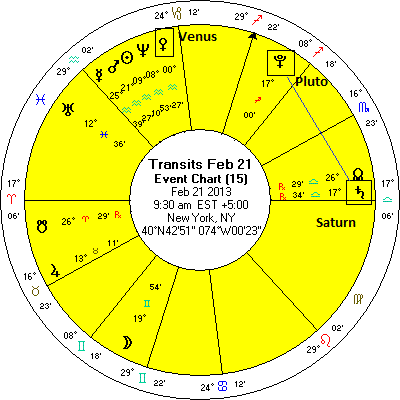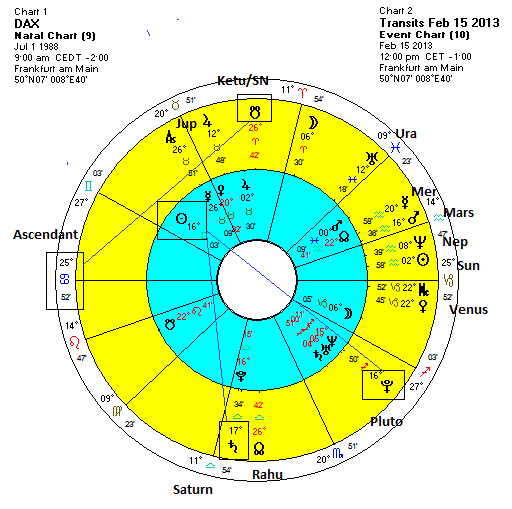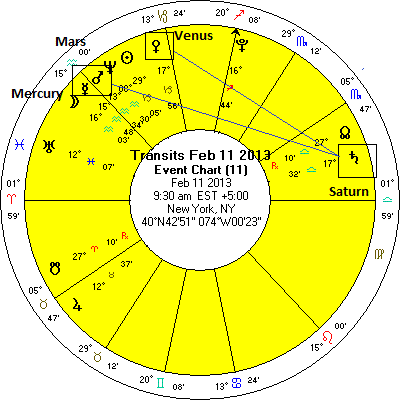
(24 February 2013) Financial markets showed some signs of nervousness last week as sequestration budget cuts loomed and evidence mounted that the Federal Reserve may end its quantitative easing program sooner than expected. US stocks were largely unchanged as the Dow finished the week at 14,000 even. Most other global markets were somewhat more bearish. Indian stocks slipped by less than 1% as the Sensex finished the week at 19,317. As expected, markets were generally stronger in the first part of the week as the planetary aspects were sufficiently bullish to offset the negativity from the Saturn's retrograde station on Monday the 18th. And perhaps not surprisingly given this Saturn influence, gold continued its decline as it closed below $1600.
More broadly, Saturn's bearish influence would appear to hang over this market as investors try to come to terms with a number of areas of uncertainty. Monday's Italian elections are one potential mine field that could shake confidence, especially as it looks somewhat unlikely that a stable coalition will be formed. The political wrangling in the US continues over the debt sequestration agreement is set to go into effect on Friday March 1. With both sides now digging in, it now seems likely that the required (Saturnian) spending cuts will take place. This is likely to reduce economic growth in 2013 and hamper recovery efforts. We should also mention that Thursday's Indian Union Budget is another possible source of worry if the anticipated investment reforms are not delivered.
Of course, bull markets have to climb a "wall of worry" so perhaps the current situation is not all that unique. And yet the planetary picture would offer the pessimistic view somewhat more confirmation. Not only is Saturn virtually stationary in the sky (and hence more powerful) but it is forming a near-exact 60 degree angle with Pluto. While various interpretations of this Saturn-Pluto aspect are possible, my sense is that this ramps up the negative potential in collective sentiment. Pluto often represents compulsory structural change involving large organizations while Saturn dictates change through destruction and loss. When it is strong and unafflicted, however, Saturn can also be a force for stability, restraint and continuity. The problem here is that this more positive interpretation of Saturn is perhaps less likely given this geometric connection with Pluto. The US budget cuts from the March 1 sequestration would appear to fit well into this aspect between Saturn (restraint) and Pluto (forced or compulsory actions). It is less clear how the Italian election result will reflect this pairing. Perhaps a win by the pro-austerity Bersani would reflect Saturn's current dominance and its emphasis on fiscal responsibility. But there is always a distorting and destructive element with Saturn that is never too far away. A shaky coalition government that includes more anti-austerity voices could also conceivably reflect some of his destructive Saturnian symbolism, especially if this encourages more caution and anxiety in Europe. In this sense, the symbolism of Saturn is not always as unambiguous as one would like in an independent variable. This makes predicting the markets with financial astrology very much an open-ended and probabilistic enterprise.
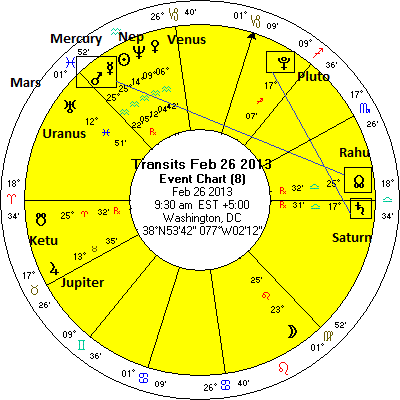
This week the planets would appear somewhat negative. There is a potent conjunction of Mercury and Mars on Monday and Tuesday that is in close aspect with Rahu (North Lunar Node). This really looks quite nasty and may reflect quickly evolving situations where information is unclear or concealed. Given the Italian elections conclude on Monday, it is not hard to draw a straight line from this alignment and some kind of negative market reaction. That said, Monday also features a fairly supportive Sun-Jupiter aspect which is usually more bullish in its effects. I wonder if this Jupiter influence will merely serve as an amplifier for the size of the reaction rather than a determiner of its content. It's hard to say with certainty. Thursday's Venus-Neptune conjunction is more bullish, so that may correlate nicely with a positive market reaction to the latest Indian Budget.

Transits for Thursday 28 February 11.00 a.m IST Mumbai, India

